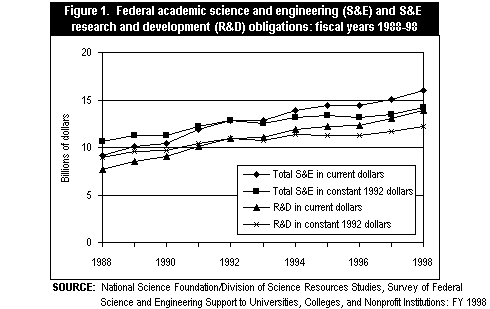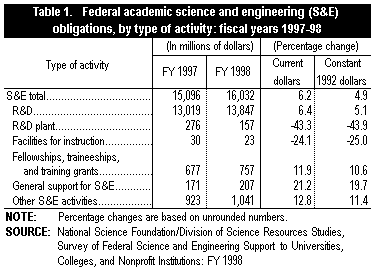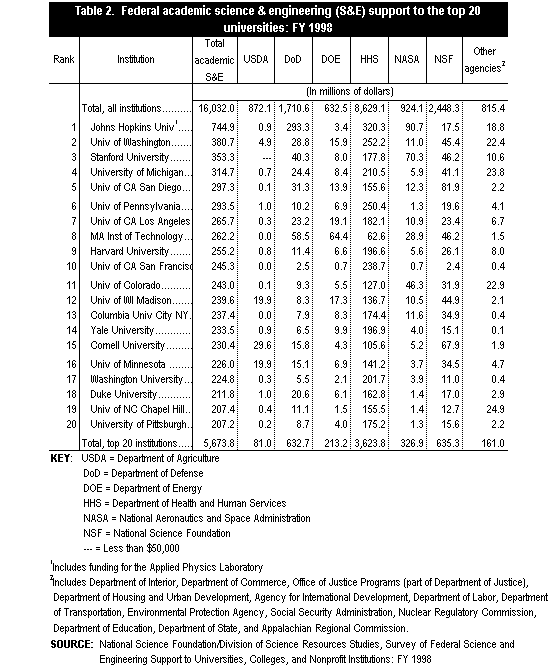Division of Science Resources Studies |
|
 |
Directorate for
Social, Behavioral and Economic Sciences |
|
|
|
National Science Foundation
|
NSF 00-312, March 8, 2000
|
Federal Academic Science and Engineering Obligations Up More Than 6 Percent in FY 1998
Richard J. Bennof
A new high of $13.8 billion was reached for Federal support for academic science and engineering research and development.
HHS accounted for 54 percent of all Federal FY 1998 academic S&E obligations.
Federal agencies obligated a new high of $16.0 billion for academic science and engineering (S&E) activities in fiscal year (FY) 1998—an increase of more than 6 percent over FY 1997, or 5 percent when adjusted for inflation. The comparable constant-dollar increase for the previous year was 3 percent. This information is based on the latest statistics from the National Science Foundation's (NSF's) annual Survey of Federal Science and Engineering Support to Universities, Colleges, and Nonprofit Institutions.
Categories of Support
Federal support for academic S&E activities primarily funds research and development (R&D) projects, which have accounted for 84 to 86 percent of the total since FY 1988 (figure 1). A new high of $13.8 billion was reached in this category in FY 1998, representing more than a 6-percent current-dollar increase—and more than a 5-percent increase in real dollars—over the previous year (table 1). The Department of Health and Human Services (HHS) accounted for 58 percent ($8.0 billion) of all Federal academic R&D obligations in FY 1998 and more than three-fourths of the total R&D increase. Federal support for academic S&E activities covers other categories as well—fellowships, traineeships, and training grants; R&D plant; facilities and equipment for instruction; general support for S&E; and other S&E activities. Funding levels for three of these categories increased in FY 1998:
- Fellowships, traineeships, and training grant support rose 12 percent to a new high of $757 million; HHS and the Department of Education were the source of 90 percent of this increase.
- Obligations for general support projects totaled $207 million in FY 1998, a 21-percent rise stemming mostly from increased HHS support. Such projects can include either funding provided without any specification of purpose other than that the funds be used for scientific projects or support for activities within a specified discipline but without specification of explicit purpose.
- Funds for other S&E activities increased 13 percent to a record high of $1.0 billion; most of this increase was supplied by NSF and the National Aeronautics and Space Administration (NASA). This category covers all academic S&E obligations that cannot be assigned elsewhere and includes activities in support of technical conferences, teacher institutes, and programs aimed at increasing the scientific knowledge of precollege and undergraduate students.
Federal obligations for R&D plant, on the other hand, fell by 43 percent to $157 million. Most of the decrease was due to reduced funding by the Department of Agriculture's (USDA's) Cooperative State Research, Education, and Extension Service; NSF; and the HHS Office of Public Health and Science. Funds for facilities and equipment for instruction were also down, dropping 24 percent to $23 million.
Agency Sources
HHS accounted for 54 percent of all Federal FY 1998 academic S&E obligations. HHS, NSF, and the Department of Defense (DOD) together provided 80 percent of total Federal academic S&E funding. S&E funds obligated by NSF and HHS each grew by nearly 9 percent in current dollars. DOD reported a decrease in its obligation level in current dollars. NASA, USDA, and the Department of Energy provided 75 percent of the remaining academic S&E total. Of those three agencies, only NASA showed a current-dollar increase: its obligations rose by 12 percent.
University Shares
The Johns Hopkins University (including its Applied Physics Laboratory) continued to be the leading academic recipient of Federal S&E support in FY 1998, with HHS and DOD the largest funders (table 2). About $5 out of every $6 in the university's $745 million total S&E obligations supported R&D programs, with most of the remainder allocated to other S&E activities. The top 20 universities, ranked by Federal academic S&E obligations, accounted for 35 percent of the total. All but one of the top 20 recipients in FY 1998 were also among the leading 20 universities in FY 1997. The new entrant was the University of North Carolina at Chapel Hill (19th after being 21st the previous year); it replaced Pennsylvania State University (22nd after being 18th). The leading six universities in FY 1997 maintained their same ordinal positions in FY 1998.
User Notes
The Federal academic S&E obligations data presented in this Data Brief were obtained from 19 agencies that supply virtually all Federal academic R&D support and that participated in the FY 1998 Survey of Federal Science and Engineering Support to Universities, Colleges, and Nonprofit Institutions. In this annual survey, data are collected on Federal S&E support by funding agency, type of institution, institutional ranking, and geographic distribution.
NSF makes available computer-generated Institutional Profiles for individual doctorate-granting institutions and schools with S&E departments that grant master's degrees. These profiles contain data from this survey and from NSF's other two academic S&E surveys: the Survey of Research and Development Expenditures at Universities and Colleges, and the Survey of Graduate Students and Postdoctorates in Science and Engineering. Data from the three surveys are also available via the World Wide Web and the Computer-Aided Science Policy Analysis and Research (WebCASPAR) database system, a user-friendly Web tool for retrieval and analyses of statistical data on academic S&E resources.
This Data Brief was prepared by:
Richard J. Bennof
Division of Science Resources Studies
National Science Foundation
4201 Wilson Boulevard, Suite 965
Arlington, VA 22230
703-306-1772 x6938
rbennof@nsf.gov


